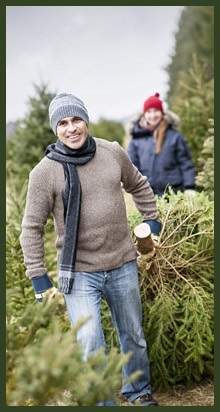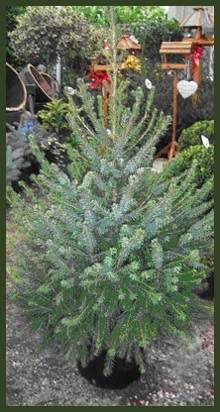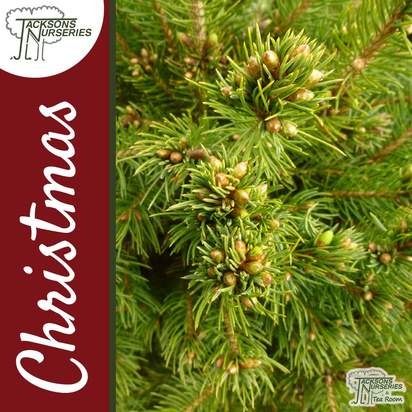Check Here Before Buying – Pot Size Matters...Not all websites offer the same. Plants in a 2-litre pot have twice the root system of a P9 or 1 litre pot.
This is a charming, dwarf evergreen conifer which forms a dense, upright cone of close-packed, stiff, deep green needles. Ideal for growing in a container or for incorporating into a rock garden, it has heaps of character and maintains its attractive, unique shape naturally so very little pruning is required.
Its slow growth rate of less than 5cm per year makes it a great choice for planting near buildings where other shrubs or small trees may grow too large. Some people also use them as a long-loved Christmas tree an ideal size for a table decoration, or small formal pyramidal tree. It must be kept well watered in periods of hot, dry weather to prevent the needles from turning brown and dropping off. Its size and shape make it a stunning addition to any garden.
The pots supplied are intended to keep some soil around the roots of the trees. We recommend you re-pot the tree into a larger pot, half barrel or other suitable container. Please unpack your tree outside where possible.
Each tree is unique and will naturally vary in appearance.
Most species of conifer are evergreen, but there are a few deciduous varieties. Some varieties of conifer are good for privacy, as they make excellent hedges. Some are also good for ground cover. They usually have scale-like leaves or needles, and bear iconic cones.
Planting and Conditions
Conifers can be planted throughout the year, but it is best to plant them in the late autumn or winter, as long as the ground is not frozen or waterlogged. Most conifers are frost proof to an extent and hardy, so they will be able to establish well throughout cooler weather.
They should be planted in full sun or partial shade, and are tolerant of most soil types, but will benefit from having compost or manure tilled into the soil prior to planting.
Conifers also need decent draining, so do not plant them in very heavy clay soil or else you will risk drowning the plant.
A hole no less than 1m across and 25cm deep should be dug when planting your conifer. Add organic material such as compost or manure to the hole, and fill it in carefully so that you don’t damage the roots.
Aftercare and Pruning
Unlike other hardwood plants, conifers need very little pruning. However, if green branches appear in trees with coloured or variegated foliage, these should be pruned more often.
Dwarf conifers are not actually dwarf, but are just slower growing. They will eventually become larger and could outgrow their space. This is fairly common with most conifers as they grow, and they can be replaced when it happens. However, their size can be controlled to some extent by pruning and trimming them.
A few conifers such as yew and Thuja, can be pruned hard and will regrow. Most conifers will not regrow from old wood if you prune into it, so take care.
Conifers can be pruned from spring through to late summer.
Newly planted conifers need very careful watering during the initial stages. They are drought proof once established and should not need too much watering, but they are very vulnerable to stress from drought if they are not watered thoroughly.
Removing weeds as soon as they appear is a good way of ensuring that valuable moisture is not lost. Mulching also reduces moisture loss from the top layers of soil.
Potential Issues
Plants can suffer from nutrient deficiencies. Overly acidic or alkaline conditions, dry spells and waterlogging can make it very difficult for plants to extract the right nutrients, and sometimes the soil doesn’t have the right nutrients to start with.
Depending on which nutrient is deficient, mulching, using compost or using a spray enriched with the right nutrients is the remedy to this common ailment.
Brown patches may occur on conifers. There are a number of causes; pests such as the cypress aphid and scale insects can be treated with sprays and foliage removal. Parasitic wasps can also be brought into greenhouses as a biological control for removal of scale insects.
Establishment problems can also occur in young or newly planted conifers. Larger specimens will experience more problems establishing, and will require much greater aftercare than younger specimens. Watering the plant well, but not excessively, and not planting it too deeply should help it to establish better.
Never spray with fertilizer or feed during hot, bright weather or you will risk scorching the leaves. Spray in overcast weather instead.
Root rot can occur when the plant is getting too much water. To remedy this, increase drainage around the plant.
Honey fungus could also occur as a result of waterlogging, or if it is already present on the plant or in the garden. It is the most destructive fungus in Britain, and unfortunately the only treatment is evacuation and burning of affected plant material.
Be sure to extract stumps and roots, as the rhizomorphs that grow during a honey fungus infestation cannot survive in soil when detached from infected material.
Xmas Tree Info Tab
Christmas Tree Size
Our Christmas trees are graded for height and marked up well in advance of cutting or digging. Your tree will be within the size range you ordered, if you want a guaranteed minimum then you are always best to order the next size up. It is always possible to reduce the size by cutting down at the base of the tree if its a bit to big. We measure our trees from the cut or the top of the pot/rootball to the middle of the leader (this is the centre branch when your star or fairy would go) so factor this in plus the height of your adornment too. Also consider that if you are having a rootballed tree the height will not include the rootball or any pot or stand you wish to use. Depending on your stand you may need to remove some of the lowest branches to get it to fit.
| Imperial (ft) | Metric (m) |
| 2-3 | 0.61 - 0.91 |
| 3-4 | 0.91 - 1.22 |
| 4-5 | 1.22 - 1.52 |
| 5-6 | 1.52 - 1.83 |
| 6-7 | 1.83 - 2.13 |
Cut/Potted Christmas Trees
Dependent on size, trees are supplied potted/rooted or cut. To ensure freshness, cut trees will have their rootball cut off as close to the dispatch date or be fresh cut directly out of the ground. Once received, it’s a good idea to keep it in a water holding stand. Our potted trees are not 'pot grown', they are dug from the field with a small rootball and placed into a non-decorative pot, as this helps the tree to remain fresher for longer over the festive period. It may be possible to plant it out after Christmas but there are no guarantees. Your Christmas tree should be kept away from radiators or any other direct source of heat, such as an open fire. Keep your potted tree well watered. The pots supplied with trees are plain black plastic pots and are not intended for decorative purposes, you should put them into a water tight pot or re-poting before watering. We recommend you remove your tree from the packaging outside. Please note that the height of the tree is including the pot and the main leader branch.
Some trees may be toxic. Please check if this tree is suitable for use in a pet environment
Should you want a tree that’s guaranteed to grow, consider buying a fully root balled or pot grown tree direct from our garden centre website.
Christmas Tree Delivery
Our Christmas Tree delivery is £19.99 per tree. We deliver from Tuesday to Friday only. Non-Christmas items requiring a pallet delivery may incur additional costs due to pallet height restrictions, if this is the case we will contact you prior to dispatch.
We always recommend someone be available to accept a delivery, however, our couriers will leave consignments in a safe place or with a neighbour. If you requested specific leave-safe delivery instructions, the courier will make every effort to accommodate this, and this is at your own risk. You can provide specific delivery instructions in the ‘Additional Information’ box during checkout. Orders will be dispatched with our couriers using a 'Next Day Service'. We are unable to provide specific delivery times, deliveries are made between 8am and 6pm. If you do not receive your order within 2 working days please let us know as soon as possible.
We make every effort to dispatch your Christmas Tree orders on the date you specify, however, there are certain times when factors outside of our control mean that this isn't always possible. We are unable to accept liability for any losses incurred whatsoever financial or otherwise as a result of your delivery not being made on the date specified.
Christmas Tree Returns
Cut and potted Christmas trees are considered perishable goods and as such are exempt from return. All Christmas trees are exempt from our 12 month guarantee. This does not affect your statutory rights.
 Cut Christmas Trees
Cut Christmas Trees Potted Christmas Trees
Potted Christmas Trees
